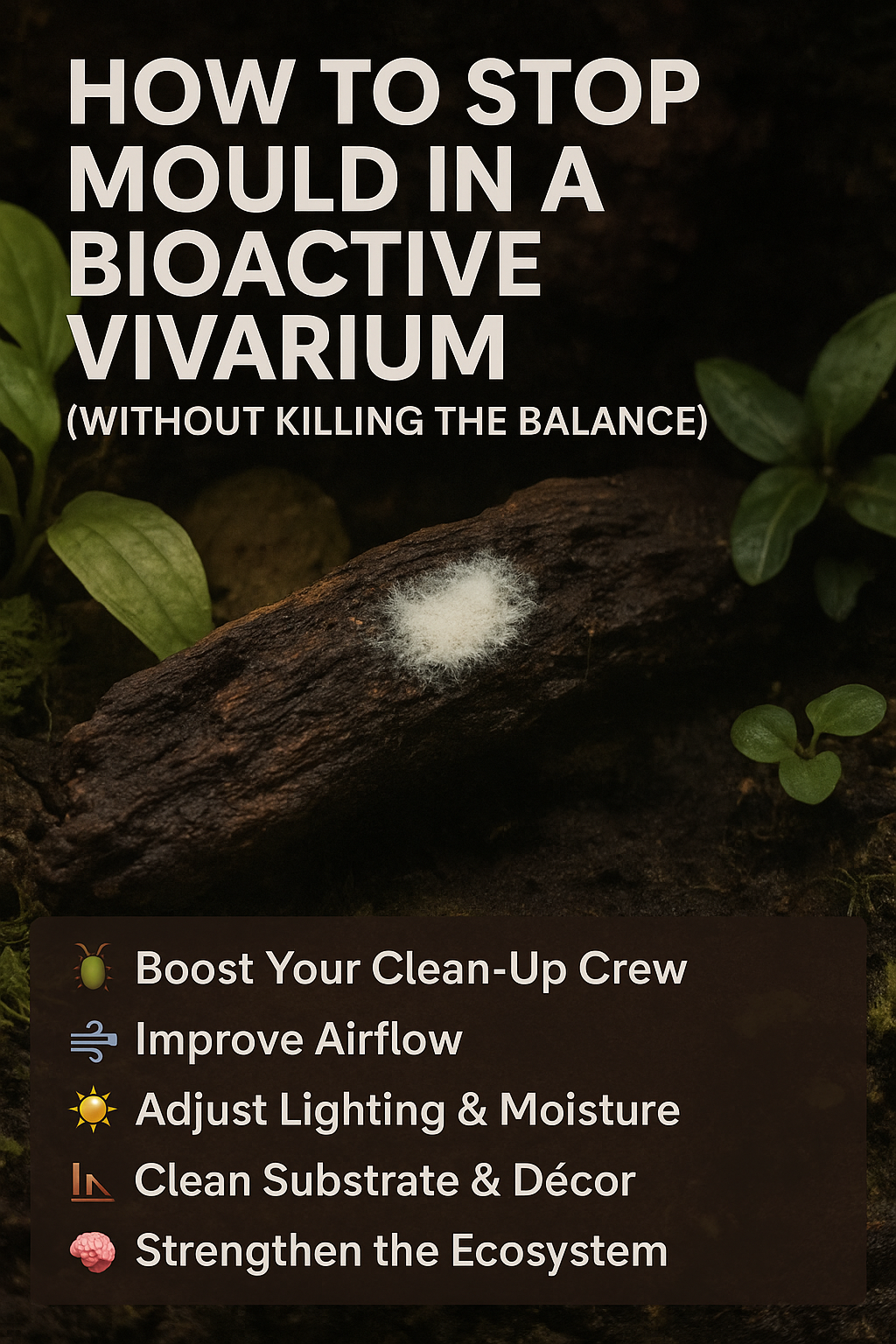In fact, a small amount of mould is completely normal in new setups. The trick is knowing when to intervene and how to do it without wiping out your microfauna or stressing your animals.
🦠 Why Mould Appears
Mould spores exist everywhere. In a sealed, humid vivarium, they find perfect conditions to grow on decaying organic matter such as wood, leaves, or uneaten food. It’s particularly common after misting or introducing new décor. :contentReference[oaicite:0]{index=0}
Even more: according to terrarium guides, early haze or light mycelium growth can actually indicate that your clean-up crew is getting started. :contentReference[oaicite:1]{index=1}
🌿 When Mould Becomes a Problem
If mould continues spreading after two weeks, starts smothering moss, or grows in thick, fuzzy patches on décor, it’s time to help your microfauna out. Left unchecked, mould can compete for oxygen at the surface layer and irritate delicate frog skin or eggs. :contentReference[oaicite:2]{index=2}
🪲 Step 1 – Boost Your Clean-Up Crew
Add a healthy culture of springtails and isopods. They are your best natural defence. In fact, keepers note that mould often recedes once microfauna populations rebound. :contentReference[oaicite:3]{index=3}
If your colony is weak or you’re just getting started, consider using a Springtail Collection Riser to culture them. These microfauna eat mould directly, helping restore balance within days.
💨 Step 2 – Improve Airflow
Mould thrives in stagnant, overly damp air. Check that your vents are clear and that airflow passes across the glass and substrate. The 3D-printed vivariums from Frogfather include angled ventilation panels designed for exactly this reason — maintaining humidity while reducing stagnant spots.
☀️ Step 3 – Adjust Lighting & Moisture
Excess misting is one of the fastest ways to fuel mould. Switch to shorter mist cycles and allow slight drying periods between sprays. Ensure your light cycle is at least 10–12 hours to encourage healthy plant growth — plants out-compete mould when thriving.
📉 Step 4 – Clean Substrate & Décor
If the outbreak is persistent, remove affected wood or décor and rinse it with hot water. Some sources suggest a mild dilution of 3 % hydrogen peroxide for targeted mould treatment. :contentReference[oaicite:4]{index=4} Avoid bleach or harsh chemicals in a bioactive setup.
Also consider adding pieces of activated charcoal to the drainage or substrate layer — it adsorbs excess moisture and nutrients that feed mould. :contentReference[oaicite:5]{index=5}
🧠 Step 5 – Strengthen the Ecosystem
Mould usually means your microfauna or airflow needs rebalancing. Think of it as feedback from your system. Add leaf litter, check your ventilation, and keep frog waste and leftover food to a minimum. Once your clean-up crew rebounds, the mould will disappear naturally. :contentReference[oaicite:6]{index=6}
🐸 Bonus Tip: Preventing Secondary Pests
Persistent mould and decay can attract snails or slugs. If you notice slimy trails or damage to soft plants, try the Bioactive Snail & Slug Removal Kit. It’s frog-safe and helps keep unwanted guests under control while your microfauna stabilise.
🌿 Long-Term Prevention Checklist
- Use only well-drained substrate and avoid water pooling. :contentReference[oaicite:7]{index=7}
- Check décor for hidden mould sources (cork bark, leaf litter).
- Maintain a fresh layer of leaf litter every 3–6 months to feed the clean-up crew.
- Mist gently; avoid high humidity spikes without ventilation.
- Keep your springtail/isopod population healthy — they should be active and visible.
✅ So to round up…..
Mould is part of every living ecosystem — it only becomes a problem when something’s out of balance. The key is adjusting, not overreacting. Strengthen your clean-up crew, keep air moving, and let nature do most of the work.
Remember: a healthy vivarium isn’t spotless — it’s alive.
❓ Frequently Asked Questions
Is mould harmful to frogs and invertebrates?
Generally, light mould growth (white fuzz, thin patches) is not harmful — it often indicates decay of organic matter and breakdown by microfauna. However, thick black mould or mould that covers significant surfaces can reduce oxygen at the substrate surface or harbour pathogens, so it should be addressed promptly.
Can I use vinegar or bleach to remove mould?
No — household bleach and vinegar are too harsh for a bioactive vivarium. Even a “natural” vinegar spray can alter pH or harm microfauna. Instead, use mild rinsing, gentle removal, and microfauna support. Some keepers use a diluted 3 % hydrogen peroxide solution for localised treatment. :contentReference[oaicite:8]{index=8}
How long will it take for mould to disappear after treatment?
With proper adjustments (ventilation, less misting, active clean-up crew), visible mould should begin to recede in a few days to a week. Full recovery of the microfauna and substrate may take 2-4 weeks, depending on the severity.
Is mould always bad in a bioactive setup?
No — small amounts of mould can be beneficial in early or freshly set-up enclosures. They’re part of the natural decomposition process. Many keepers report that if microfauna populations are active and the system matures, the mould will naturally fade. :contentReference[oaicite:9]{index=9}
What’s the best humidity for preventing mould without drying plants?
For most dart frog and tropical plant enclosures aim for humidity levels of ~ 75-90 % during the day with occasional low-humidity breaks (e.g., down to 60-65 %) or a short “dry” period at night. Good airflow during the day helps avoid stagnant pockets where mould thrives.
When should I replace substrate or décor because of mould?
If mould has penetrated deeply into substrate and is accompanied by foul odour, soil slump, or fungus-fruiting bodies (mushrooms), it’s time to replace the affected layer or décor. Otherwise, boosting microfauna and airflow usually suffices.



